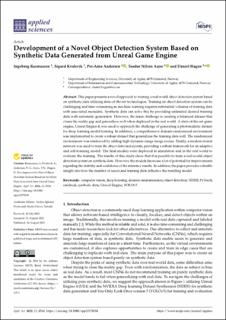Development of a Novel Object Detection System Based on Synthetic Data Generated from Unreal Game Engine
Peer reviewed, Journal article
Published version
Permanent lenke
https://hdl.handle.net/11250/3022134Utgivelsesdato
2022Metadata
Vis full innførselSamlinger
Originalversjon
Rasmussen, I., Kvalsvik, S., Andersen, P.- A., Aune, T. N. & Hagen, D. (2022). Development of a Novel Object Detection System Based on Synthetic Data Generated from Unreal Game Engine. Applied Sciences, 12 (17), Artikkel 8534. https://doi.org/10.3390/app12178534Sammendrag
This paper presents a novel approach to training a real-world object detection system based on synthetic data utilizing state-of-the-art technologies. Training an object detection system can be challenging and time-consuming as machine learning requires substantial volumes of training data with associated metadata. Synthetic data can solve this by providing unlimited desired training data with automatic generation. However, the main challenge is creating a balanced dataset that closes the reality gap and generalizes well when deployed in the real world. A state-of-the-art game engine, Unreal Engine 4, was used to approach the challenge of generating a photorealistic dataset for deep learning model training. In addition, a comprehensive domain randomized environment was implemented to create a robust dataset that generalizes the training data well. The randomized environment was reinforced by adding high-dynamic-range image scenes. Finally, a modern neural network was used to train the object detection system, providing a robust framework for an adaptive and self-learning model. The final models were deployed in simulation and in the real world to evaluate the training. The results of this study show that it is possible to train a real-world object detection system on synthetic data. However, the models showcase a lot of potential for improvements regarding the stability and confidence of the inference results. In addition, the paper provides valuable insight into how the number of assets and training data influence the resulting model.

